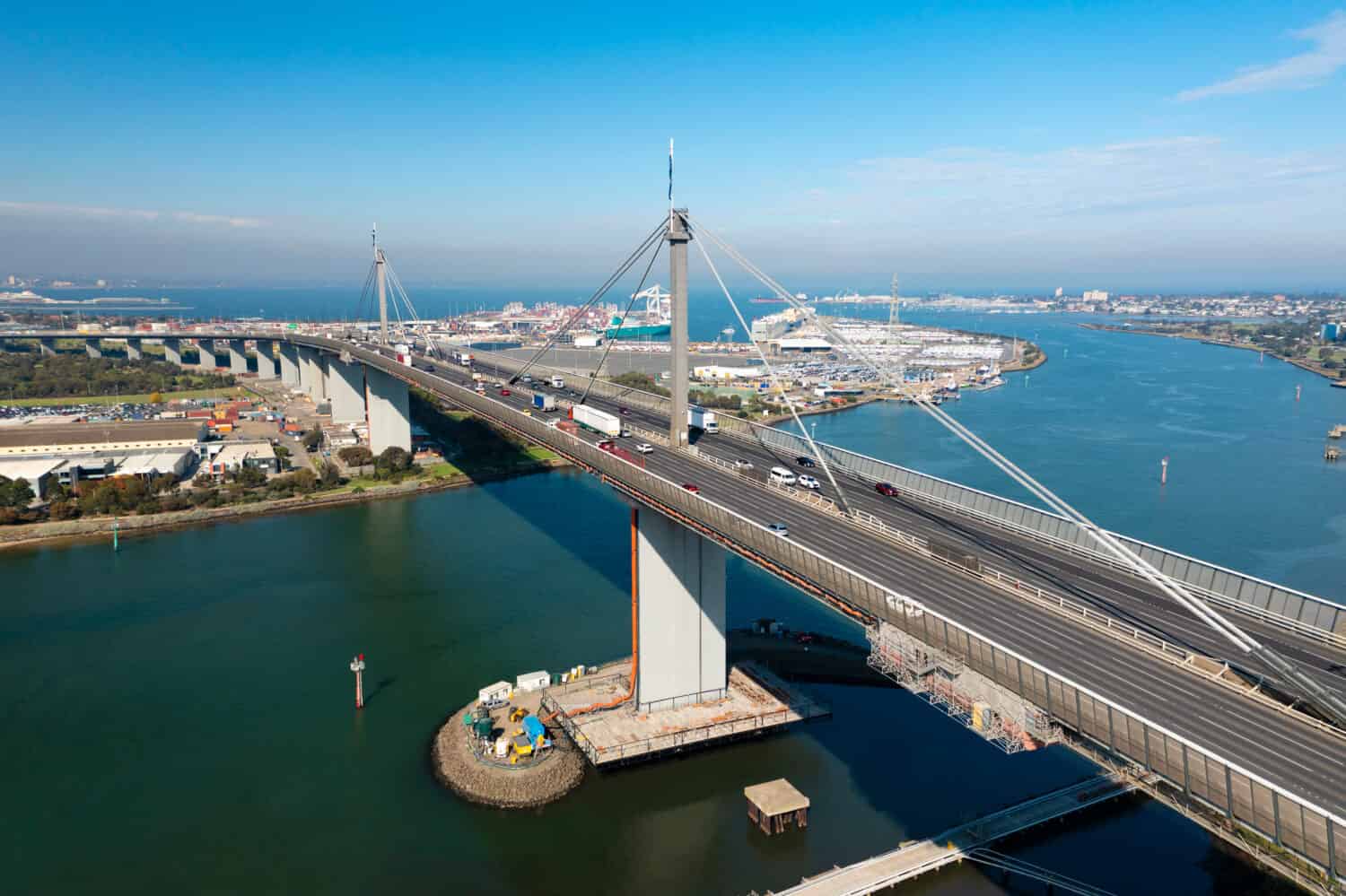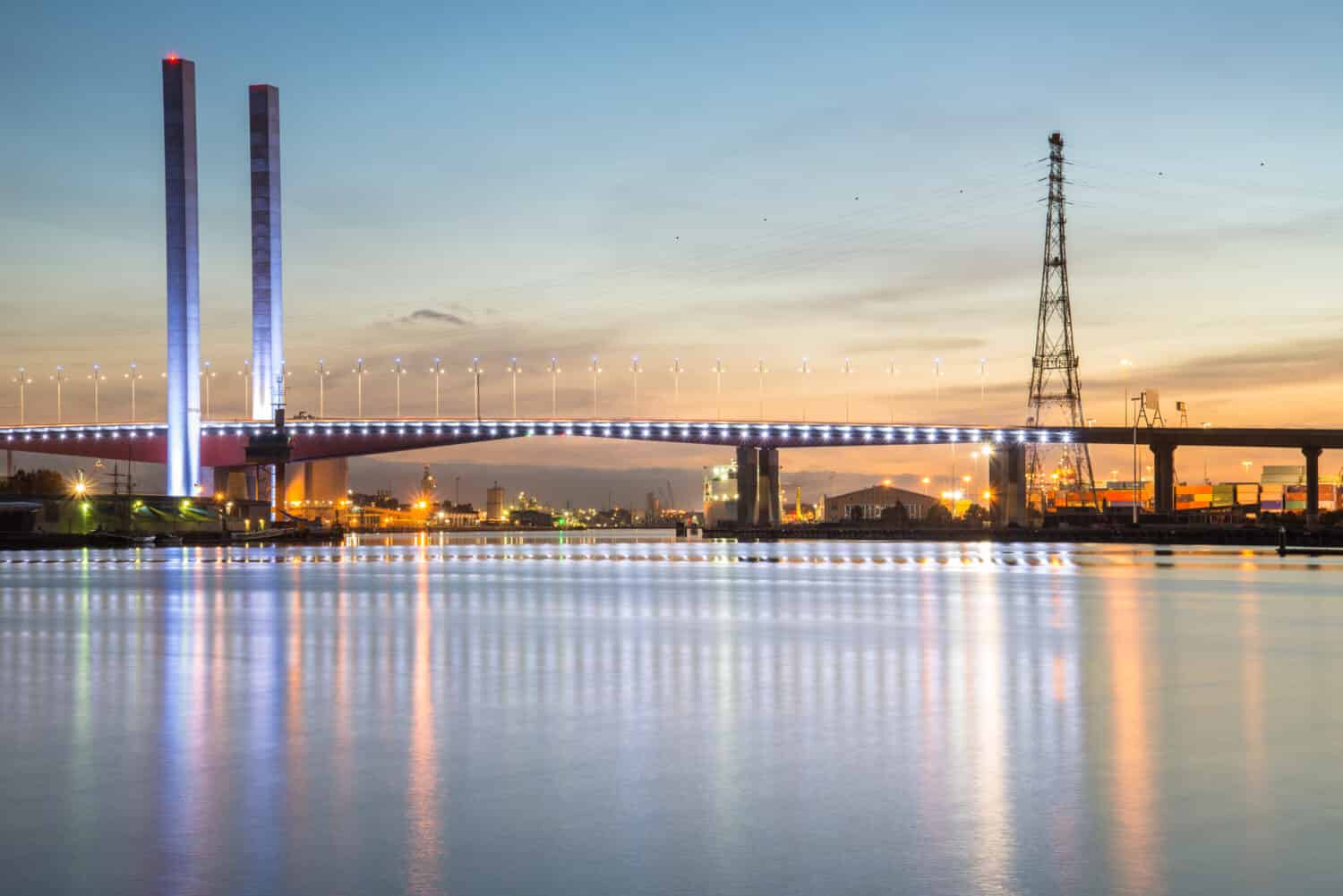Victoria, Australia, boasts a remarkable collection of bridges that not only serve as vital transportation links but also stand as impressive architectural feats. From iconic structures in Melbourne to key river crossings connecting regions, these bridges play a crucial role in enhancing connectivity and facilitating the movement of people and goods.
As we delve into the world of engineering marvels, join us on a journey to explore the largest bridges in Victoria. From the towering spans that span rivers to the elevated roadways that stretch across vast landscapes, these structures not only captivate with their size but also leave an indelible mark on the landscape and the communities they serve.
So, fasten your seatbelts and get ready to traverse the metaphorical highways of engineering excellence as we unveil the grandeur of Victoria’s largest bridges!
1. The West Gate Bridge

Aerial photo of traffic on West Gate Bridge in Melbourne, Victoria.
©ymgerman/Shutterstock.com
The West Gate Bridge is an iconic structure and one of the largest bridges in Australia. Its impressive dimensions and scale make it a significant landmark in the country’s infrastructure landscape.
Dimensions And Scale Of The Bridge:
The West Gate Bridge spans the Yarra River in Melbourne, connecting the city’s western suburbs to the central business district. With a length of approximately 2.6 kilometers (1.6 miles), it stands tall as one of the longest bridges in Australia. Rising to a height of around 58 meters (190 feet) above the river, it commands a majestic presence.
Supporting Infrastructure:
The construction of the West Gate Bridge was an engineering marvel, showcasing innovative design and structural elements. Its cantilever structure allows for the bridge to support its massive weight and withstand the forces exerted on it. The bridge’s steel truss sections provide strength and stability, while the use of reinforced concrete in its piers and abutments ensures durability.
Transportation Lifeline:
The West Gate Bridge serves as a vital transportation lifeline, handling heavy traffic loads on a daily basis. It features a total of eight lanes, allowing for a significant flow of vehicles in both directions. This capacity greatly eases the congestion experienced by commuters and facilitates the movement of goods and services between Melbourne’s western suburbs and the city center.
Iconic Status:
The West Gate Bridge holds immense significance not only as a critical transportation link but also as an iconic symbol of engineering excellence. Its construction marked a milestone in the development of Australia’s transportation systems. The bridge’s imposing presence has become synonymous with Melbourne’s skyline, serving as a recognizable landmark both for locals and visitors alike.
Furthermore, the West Gate Bridge’s influence extends beyond its physical structure. It represents the determination and resilience of the Australian people, as it was rebuilt after a tragic collapse during construction in 1970. This event led to significant safety improvements in engineering practices, making the bridge a symbol of progress and a testament to the nation’s commitment to innovation and safety.
2. The Bolte Bridge

Bolte bridge is the iconic landmark of Docklands, Melbourne, Australia.
©Boyloso/Shutterstock.com
The Bolte Bridge, located in Victoria, Australia, is renowned as one of the largest bridges in the country. Its impressive dimensions and scale make it an iconic structure in the state.
Dimensions And Scale Of The Bridge:
The bridge spans approximately 2.5 kilometers (1.5 miles) in length, connecting the western and northern suburbs of Melbourne to the central business district. This considerable length allows for smooth and efficient transportation across the Yarra River.
With a towering height of around 55 meters (180 feet) above the river, the Bolte Bridge provides ample clearance for water traffic, ensuring a seamless flow of ships and boats beneath its magnificent structure.
While specific weight figures may not be readily available, the bridge’s construction is built to withstand heavy loads, contributing to its strength and stability.
Supporting Infrastructure:
The construction of the Bolte Bridge represents an engineering marvel, showcasing innovative design and structural elements that contribute to its size and strength.
The bridge features a cable-stayed design, utilizing multiple towers to support the weight of the bridge deck. This design allows for a significant span between the towers, enhancing the bridge’s overall stability.
Reinforced concrete piers and abutments form the foundation of the Bolte Bridge, providing essential support and structural integrity. The bridge deck itself is a combination of steel and concrete, ensuring durability and longevity.
Transportation Lifeline:
Functioning as a vital transportation lifeline, the Bolte Bridge demonstrates its capacity to handle heavy traffic loads. It serves as a critical link for commuters traveling between the western and northern suburbs and the bustling central business district of Melbourne.
With a total of eight lanes, the Bolte Bridge can accommodate a substantial flow of vehicles in both directions, effectively reducing congestion and ensuring smooth traffic flow. This capacity makes it a crucial component of Melbourne’s transportation network.
Iconic Status:
The Bolte Bridge holds immense significance as a symbol of Victoria’s transportation infrastructure. Its imposing structure and vital role in connecting different parts of Melbourne have earned it an iconic status in the state.
Beyond its physical attributes, the Bolte Bridge has made a profound impact on the development of transportation systems in the country. It has improved connectivity and accessibility, fostering economic growth and facilitating the movement of people and goods. The bridge’s architectural prominence has become ingrained in the city’s identity, representing progress, innovation, and Melbourne’s commitment to creating a modern and efficient transportation network.
3. Princes Bridge:

Warm morning light on high-rise towers in Melbourne CBD above Princes bridge across Yarra river.
©Taras Vyshnya/Shutterstock.com
Princes Bridge, located in Victoria, Australia, is not one of the largest bridges in the country, but it holds immense historical and cultural significance. While it may not boast grand dimensions, its charm and historical value make it an iconic structure in the state.
Dimensions And Scale Of The Bridge:
The bridge spans approximately 110 meters (361 feet) in length, crossing the Yarra River and connecting Swanston Street to St Kilda Road. Its modest height of about 9 meters (30 feet) provides a picturesque view of the river and the surrounding cityscape.
Specific weight figures for Princes Bridge are not readily available, but it is constructed with sturdy materials to ensure its durability and longevity.
Supporting Infrastructure:
The construction of Princes Bridge represents an engineering feat for its time and showcases the architectural style of the era. Built in the 1880s, it exemplifies the innovative design and structural elements of that period.
The bridge features a combination of wrought iron and sandstone, reflecting the architectural trends of the late 19th century. The wrought-iron arches provide the bridge with strength and stability, while the sandstone piers and abutments add an aesthetic touch to its design.
Transportation Lifeline:
While Princes Bridge may not have the capacity to handle heavy traffic loads like some of the larger bridges in Australia, it still serves as an important transportation link within Melbourne.
With a total of four lanes, Princes Bridge accommodates a significant flow of vehicles in both directions. As a result, it allows for smooth traffic flow across the Yarra River. Its central location and connection to major thoroughfares make it an essential artery in the city’s transportation network.
Iconic Status:
Princes Bridge holds significant historical and cultural importance in Victoria. It serves as a reminder of Melbourne’s rich heritage and its evolution as a modern city.
The bridge’s historical significance stems from its role as one of the city’s oldest river crossings. It has witnessed the growth and development of Melbourne. Plus, it has served as a vital link between different parts of the city for over a century.
Princes Bridge’s influence on the development of transportation systems in the country may not be as pronounced as some other bridges. However, its historical and cultural significance cannot be overlooked. It stands as a symbol of Melbourne’s heritage and the city’s commitment to preserving its architectural legacy.
In Conclusion
In conclusion, the largest bridges in Victoria stand as remarkable feats of engineering and architectural excellence. These monumental structures not only serve as vital transportation links but also represent the ingenuity and innovation of their creators. Each of these bridges showcases the ability of human endeavor to push boundaries and overcome challenges. These bridges serve as iconic landmarks, connecting communities, facilitating economic growth, and shaping the transportation landscape of Victoria. As testaments to human achievement, these bridges will continue to inspire and awe for generations to come.
The photo featured at the top of this post is © Alex Cimbal/Shutterstock.com
Thank you for reading! Have some feedback for us? Contact the AZ Animals editorial team.







